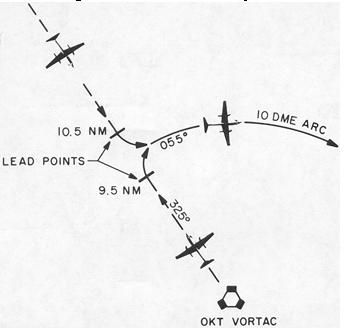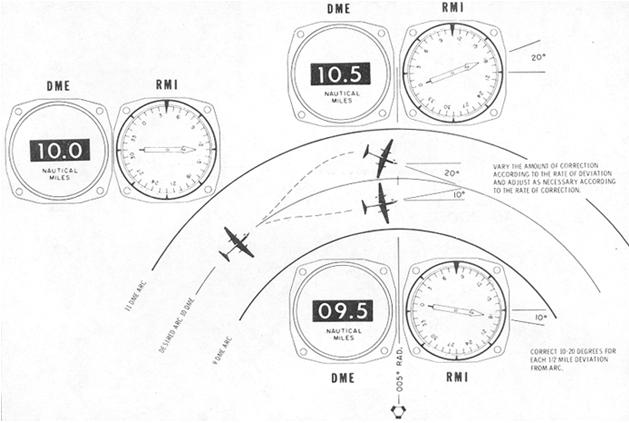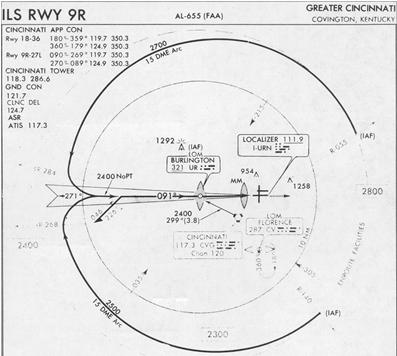
The FAA is publishing an increasing number of instrument approach procedures which incorporate DME arcs. The procedures and techniques given here for intercepting and maintaining such arcs are applicable to any facility which provides DME information. Such a facility may or may not be collocated with the facility that provides final approach guidance.
It is recognized that the pilot, particularly in a single pilot operation, is too busy during an instrument approach to use formulas for the computation of leads for arc and radial interception, therefore, none are given.
Unless you are highly proficient in the use of the airborne equipment and in performing arc procedures, it is recommended that DME arcs be flown in IFR weather conditions only when RMI equipment is available.
Figure 8-18. DME arc interception.
 |
Refer to Figure 8-18 and follow these steps to intercept the 10
DME arc when inbound on the 325 radial:
1. Track inbound on the OKT 325° radial, frequently checking
the DME mileage readout.
2. Since a 0.5 nautical mile lead is satisfactory for groundspeeds
of 150 knots or less, start the turn to the arc at 10.5 miles. At higher
groundspeeds, use a proportionately greater lead.
3. Continue the turn for approximately 90°. The roll-out
heading will be 055° in no-wind conditions.
4. During the last part of the intercepting turn, monitor the
DME closely. If it appears that the arc is being overshot, roll out of
the turn early. If the arc is being undershot, continue past the originally-planned
rollout point.
The procedure for intercepting the 10 DME arc when outbound is basically the same, the leadpoint being 10 miles minus 0.5 miles or 9.5 miles.
When flying a DME arc such as that illustrated in Figure 8-19, it is important that you keep a continuous mental picture of your position relative to the facility. Since the wind drift correction angle is constantly changing throughout the arc, wind orientation is important. In some cases, wind can be used in returning to the desired track. Arcs of large radii are easier to fly because of their "flat" curve. High airspeeds require more pilot attention because of the higher rate of deviation and correction. Maintaining the arc is simplified by keeping slightly inside the curve. Thus, the arc is always turning toward the aircraft and interception may be accomplished by holding a straight course. If you are outside the curve, the arc is "turning away" and a greater correction is required.
With an RMI, in a no-wind condition, you should theoretically be able to fly an exact circle around the facility by maintaining a relative bearing of 90° or 270°. In actual practice, a series of short legs are flown. To maintain the arc (Fig. 8-19), proceed as follows:
1. With the RMI bearing pointer on the wingtip reference (90° or 270° position) and the aircraft at the desired DME range, maintain a constant heading and allow the bearing pointer to move 5° to 10° behind the wingtip. This will cause the range to increase slightly.
Figure 8-19. Using DME and RMI to maintain arc.
 |
2. Next, turn toward the facility to place the bearing pointer
5° to 10° ahead of the wingtip reference, then maintain heading
until the bearing pointer is again behind the wingtip. Continue this procedure
to maintain the approximate arc.
3. If a crosswind is drifting you away from the facility, turn
the aircraft until the bearing pointer is ahead of the wingtip reference.
If a crosswind is drifting you toward the facility, turn until the bearing
pointer is behind the wingtip.
4. As a guide in making range corrections, change the relative
bearing 10° to 20° for each 1/2 mile deviation from the desired
arc. For example, in no-wind conditions, if you are 1/2 mile outside the
arc and the bearing pointer is on the wingtip reference, turn the aircraft
20° toward the facility to return to the arc (Fig. 8-19).
Without an RMI, orientation is more difficult since you do not have a direct azimuth reference. However, the procedure can be flown using the OBS and CDI for azimuth information and the DME for arc distance. Refer again to Figure 8-18, and follow these steps:
1. If the rollout on the 055° heading places the aircraft
on the arc, the DME will read 10.0 miles.
2. Set the OBS to 335°; when the CDI centers, you are crossing
the 335 radial.
3. If the CDI reads right of center and the DME reads 10.5 miles,
you are outside (left) of the arc and approaching the 335 radial. Correct
heading to the right and monitor the DME for closure with the arc. If you
are inside (right) of the arc, maintain heading to intercept the arc.
4. As the 10 DME arc and the 335 radial are achieved, set the
OBS ahead 20° to 335° and turn to a heading 100° from the 335
radial (to a no-wind heading of 075°). Hold this heading until the
355 radial is crossed or the arc is intercepted. At this point, set the
OBS ahead 20° and turn to a heading 100° from the radial you have
just crossed. This technique will maintain a track slightly inside the
10 DME arc in no-wind conditions.
When intercepting a radial from a DME arc, the lead will vary with arc radius and groundspeed. For the average general aviation aircraft flying arcs such as those depicted on most approach charts at speeds of 150 knots or less, the lead will be under 5°. There is no essential difference between intercepting a radial from an arc and intercepting it from a straight course. With an RMI, the rate of bearing movement should be monitored closely while flying the arc. Set the course of the radial to be intercepted as soon as possible and determine the approximate lead. Upon reaching this point, start the intercepting turn. Without an RMI, the technique for radial interception is the same except for azimuth information, which is available only from the OBS and CDI.
Figure 8-20. Localizer interception from DME arc.
 |
The technique for intercepting a localizer from a DME arc is similar to that described above for intercepting a radial. At the depicted lead radial (LR-284 or LR-268 in Fig. 8-20), a pilot having a single VOR/LOCALIZER receiver should set in the localizer frequency. If the pilot has dual VOR/LOCALIZER receivers, one unit may be used to provide azimuth information and the other set to the localizer frequency.